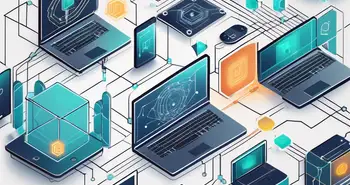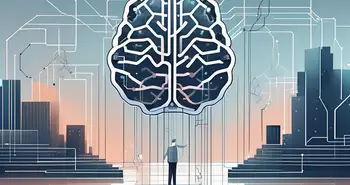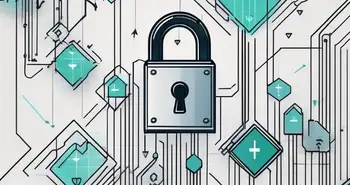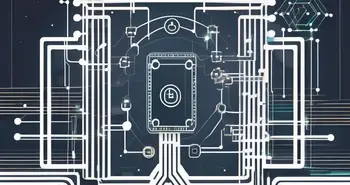The Future Of Blockchain
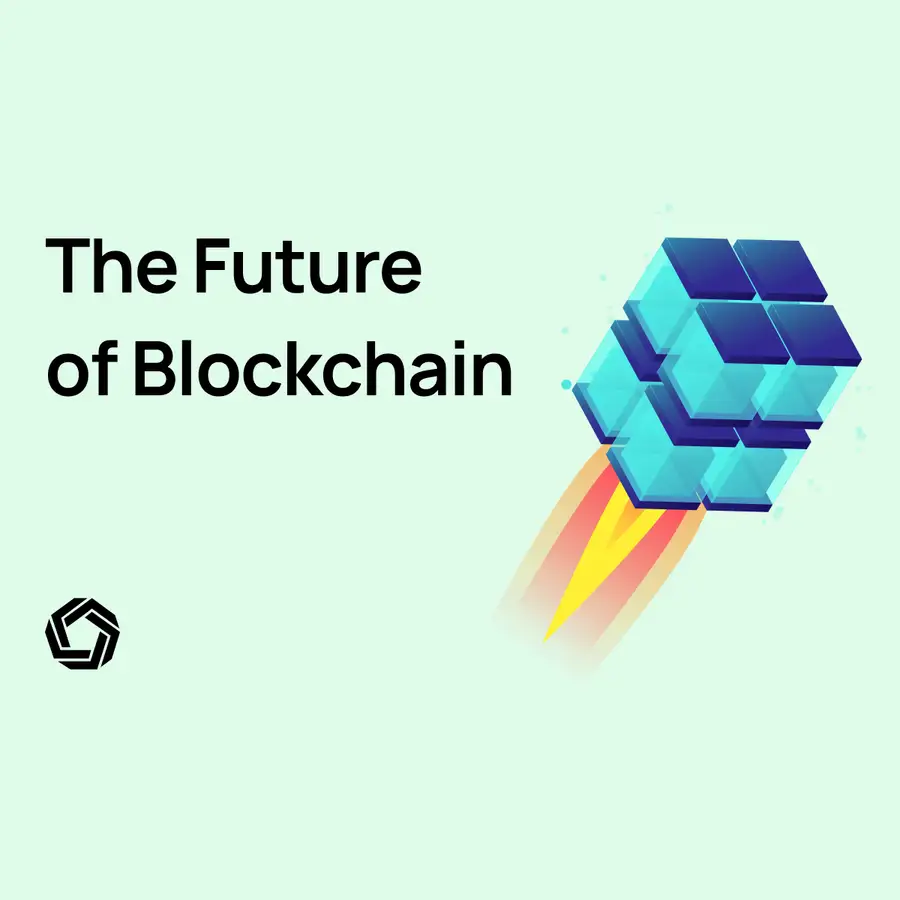
When you search for information about the future of blockchain online, you will get many conflicting results. Some articles are just a collection of buzzwords, adding to the vague understanding of blockchains. Other articles like “Forget Bitcoin: Blockchain is the Future”, add to the confusion around blockchains.
The title adds to the confusion because Bitcoin enabled the entire field of Blockchain, being the oldest and biggest Blockchain. The Bitcoin Network has been running for over two decades now, with almost no financial loss on the chain itself; it is now, in meaningful ways, the most reliable and secure financial network in the world.
It's puzzling because Bitcoin enabled the entire field of Blockchain, being the oldest and biggest Blockchain.
This article will give you a proper understanding of Blockchain, its use cases, current state, and future outlook.
Byzantine Problem
Let's start the article by talking about the Byzantine Problem and how Satoshi Nakamoto solved it to enable a whole industry of Blockchain. The Byzantine Problem solves a specific coordination problem in computer science. A problem that is relying on the participants' trust, which is very important when working online as you often need to know your counterparty.
The challenge lies in preventing the system's catastrophic collapse, which necessitates a unified approach agreed upon by all participants. However, some of these participants must demonstrate a much higher level of reliability.
So the analogy for it is that a group of generals need to coordinate their attack on a city. They can only communicate through messengers, but some messengers could be traitors who might send false messages or fail to deliver messages.

The miners act like messengers to solve this problem in the Bitcoin network. They compete to solve a complex puzzle, which requires a lot of computational power. Once a miner solves the puzzle, they broadcast the solution and the new block of transactions to the network.
The puzzle-solving step is crucial because it proves that the miner has put in real effort (computational work) to find the solution. This proof gives the Bitcoin network its name, “Proof of Work.” It prevents malicious actors from easily manipulating the network.
When a miner successfully adds a block to the Blockchain, other miners in the network verify the solution. They agree on the longest valid chain, which is the chain with the most computational work put into it. This agreement allows all the nodes in the network to reach a consensus on the correct version of the Blockchain, even if some miners are malicious or unreliable.
Solving the byzantine's general problem allows us to collaborate online without trusting middlemen or other parties. It enables us to transact without borders and in a decentralized way without relying on centralized authorities. So, when before we had to rely on other parties to verify transactions or specific actions online, blockchains eliminate the need for that. In a general sense, blockchains are an improvement in trust.
How the Blockchain Works
The solution to the Byzantine general's problem was basically the birth hour of blockchain technology. In simple terms, the Blockchain is simply a collection of information that cannot be changed. Every new information is added in a so-called block to the chain of previous blocks. Once the new block is added, you cannot change it anymore. Again, the main function is that the information cannot be changed once confirmed and added to the Blockchain.
Blockchains have different functions; you can store almost any information on a blockchain. Social Networks can be entirely run on a blockchain, where every tweet is recorded to the Blockchain.
Running social media networks on a blockchain could be crucial to addressing the challenges of fake media and propaganda. Content posted on these platforms, such as tweets, images, and videos, would become tamper-resistant and permanently recorded. This would prevent malicious actors from altering historical records or spreading false information for propaganda. This false information spread throughout history, as seen in the example of Stalin's manipulation of photographs during the Great Purge. It could help combat the spread of misinformation and disinformation, safeguarding the public from the potentially harmful impacts of manipulated media.

The original use case for the Blockchain was to store financial transaction data, as this data directly correlates to people's wealth and freedom. Thus, Satoshi Nakamoto created Bitcoin to give a trustless alternative to the people:
“The root problem with conventional currency is all the trust required to make it work. The central bank must be trusted not to debase the currency, but the history of fiat currencies is full of breaches of that trust.”
History is marred with instances where centralized systems and financiers broke the trust reposed by individuals, organizations, and nations. Let's take a brief walk down the memory lane.
The catastrophic event of 1929's Great Depression was a glaring instance of a centralized trust failure. The Stock Market Crash and the subsequent bank failures due to corrupt practices, over-speculation and an ill-conceived financial system resulted in the loss of fortunes for millions of investors. If blockchain technology and Bitcoin were in place, investor trust would not have been breached.
Fast-forward to 2008, the global financial crisis was triggered by the fall of the investment bank Lehman Brothers. The financial misappropriation, unseen risk correlations, and a not-so-transparent credit-derivate market led to a worldwide economic meltdown. Bitcoin could have offered a decentralized, non-inflationary alternative to fiat currencies, bypassing the poorly managed centralized fiscal policies.

The Bitcoin Protocol enforces strict rules that everyone must follow, making fraud almost impossible. Each Bitcoin transaction is transparently recorded on the Blockchain, meaning everyone can see where the coins are transferred. This transparency gives assurance to participants that their transactions are secure and incorruptible.
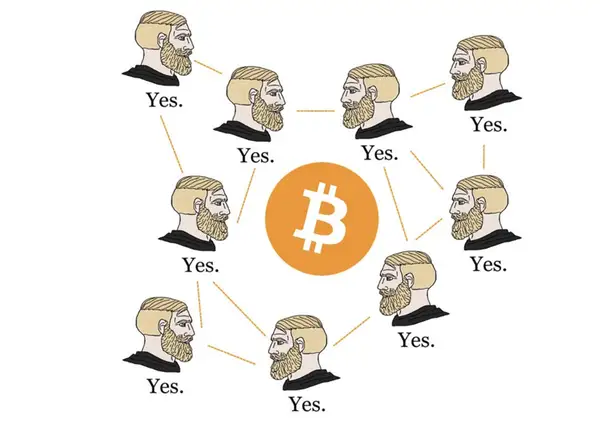
The Minimum Nakamoto Coefficient
Besides just relying on blockchains being trustless, there should also be a certain calculation to check if the Blockchain you are using is doing what it is supposed to be: a decentralized, trustless entity. For that purpose, the minimum Nakamoto coefficient was proposed. It is a novel measure proposed to assess the decentralization of a blockchain system by Balaji Srinivasan. Let's say that decentralization is one of the most critical parts of a blockchain. This coefficient quantifies the minimum number of entities needed to compromise a subsystem within the blockchain network.
The minimum Nakamoto coefficient aims to identify the essential decentralized subsystems that compose the entire system, such as mining, clients, developers, nodes, and exchanges. By determining how many entities need to be compromised within each subsystem to gain control over them, one can gauge the overall decentralization of the entire blockchain network.
A higher minimum Nakamoto coefficient indicates a more decentralized system, requiring compromising more entities to gain control. This measure provides valuable insights for tracking historical trends, identifying decentralization bottlenecks, and making informed decisions to optimize the system's design for enhanced decentralization.
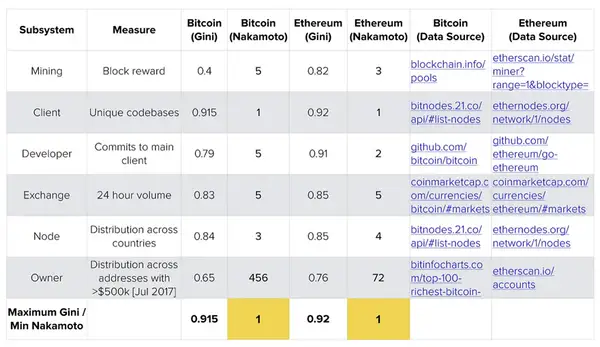
Current State of Blockchain
The current state of blockchain technology is still in its infancy. This section will give you a quick overview of the different layer 1 solutions, explain why these solutions were often needed and what layer 2 solutions were developed.
As you can already tell, layer 1 blockchains are the pillars of the crypto ecosystem. Layer 1 solutions included blockchains like Bitcoin and Ethereum and were created for particular purposes. Most of the time, they handle rather basic tasks like transaction recording or securing the network. However, they sometimes have limitations such as transaction throughput and thus, layer 2 blockchains were developed as an addition to the layer 1 solution.
Layer 2 solutions are like an extra layer built on the foundation. They take some work off the main Blockchain and can thus process transactions faster and with lower fees. Layer 2 solutions are often less secure or decentralized than layer 1 solutions.
In simple terms, Layer 1 is the main layer where everything starts, and Layer 2 is like an extra layer that helps the main layer work better, making transactions faster, cheaper, and more efficient.
Layer 1 Blockchains
The main blockchains for layer 1 are Bitcoin, Ethereum, Binance Smart Chain, Cardano and Polkadot. Each of these blockchains was created to address a certain issue. These blockchains also have very different metrics like decentralization, energy consumption, transaction throughput, transaction fees, etc.
As we already wrote before, the Bitcoin blockchain is, to this day, the oldest and most reliable chain. The use case for Bitcoin was to create a censorship-resistant peer-to-peer electronic cash system so that money could be sent worldwide without reliance on third parties and intermediaries. The second most important chain is Ethereum. Often these chains get compared a lot, and people argue about which coin or Blockchain is better. However, these blockchain systems are solving somewhat different problems. Ethereum was not created as a peer-to-peer electronic cash system but as a more versatile platform. The Ethereum blockchain enables to create decentralized applications with smart contracts. So, all projects that are a bit more sophisticated, like DeFi, NFTs, or Decentralized Social Networks, mostly use the Ethereum blockchain.
Then there are the other layer 1 solutions like Binance Smart Chain (BSC), Cardano (ADA), or Polkadot (DOT) that were mostly created to have more throughput and lower transaction costs with more scalability and interoperability for the future, as this was a feature the Bitcoin and Ethereum blockchain were lacking at a certain point.
Layer 2 Blockchains
As the Ethereum and Bitcoin blockchains were running into scalability issues at a certain point, many projects tried to create layer 2 solutions for the big chains. These solutions should help the performance to handle higher transaction volumes, reduce fees, and increase speed. In a simplified way, take off a lot of the load from the Blockchain, do it on the second layer where you still have the capacity, and give the results back to layer 1.
A known solution would be Rollups (Optimistic Rollups and ZK-Rollups), the Lightning Network or Polygon (MATIC). Rollups bundle transactions off-chain before settling them on the main Ethereum chain, reducing gas fees and increasing scalability. The Lightning Network is an L2 for Bitcoin that aims to improve scalability by enabling fast and low-cost micropayments. It operates off-chain and settles transactions on the Bitcoin blockchain periodically. Finally, Polygon provides a framework for building scalable and interoperable DApps, while leveraging the security of the Ethereum mainnet.
Surely, other Layer 1 and Layer 2 solutions also exist. Many companies propose different solutions to become the preferred solution. However, to this day, Bitcoin and Ethereum are probably the most used solutions as they are reasonably decentralized, and both have great communities behind them. That is often a major hurdle behind the other chains, as they cannot compete in terms of developer community and decentralization. That shows that blockchain adoption is heavily linked to network effects.
Adoption of Blockchain Technology
Even though the adoption of underlying blockchain technology and the network effect may seem like magic, it is important to understand for the future of blockchain technology why some blockchains are used more than others. The answer probably lies within what Ali Yahya calls the Network Flywheel.
Traditionally, the defensibility of businesses has relied on privileged access to resources that confer advantages, such as new technologies, private user data, key partnerships, capital assets, distribution channels, or raw materials. However, blockchains possess a unique characteristic: they are open-source and permissionless. The code they are built upon is freely available for anyone to examine, and their functionality is accessible to anyone with an internet connection.
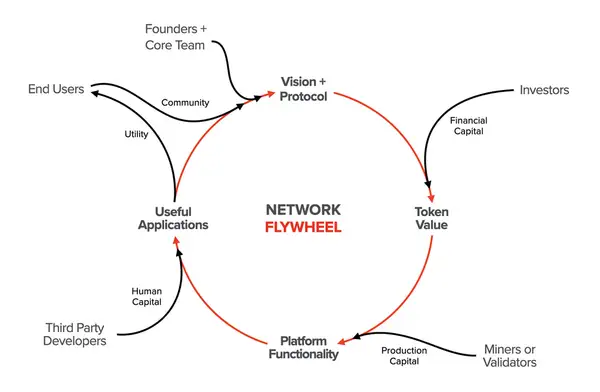
Here's the paradox: a correctly designed blockchain cannot benefit from exclusive resources. Its decentralized nature means that no small group of individuals holds unilateral control or disproportionate power over it. For a blockchain to truly be a blockchain, there can be no privileged actors.
Surprisingly, as a founder, you can give away every line of code that comprises your product, relinquish control over the movement you initiate, and still capture some of the value you create. The resolution lies in a well-designed blockchain's built-in incentive structure, which generates a multi-sided market with powerful network effects. Defensibility doesn't originate from the code itself but rather from the network it engenders.
How does this mechanism work? It all commences with the founding team, who set the flywheel in motion by articulating a new vision for a decentralized network.
If the vision is sufficiently compelling, a community begins around it. The project transforms into a movement, and a core team of developers emerges to construct the protocol. Momentum may reach a point where the network's token acquires an initial monetary value, even if the protocol's development remains ongoing. This allows the community to attract external financial capital to aid their efforts.
The token's initial value serves another purpose. Once complete, the protocol incentivizes a distinct set of participants—miners (or validators in proof-of-stake networks). Miners and validators contribute computational resources, the production capital, to the network in exchange for protocol rewards. These resources grant the network functionality and security.
With a functional and secure network, third-party developers can leverage its capabilities to build useful applications. These applications generate real-world value for end-users, who, in turn, drive demand for the token. By becoming part of the community, users reinforce the vision at the protocol's core, completing the circle.
A larger community fosters increased demand for the token, creating stronger incentives for miners to support the network's functionality. This, in turn, encourages developers to build useful applications, further enhancing utility for users and strengthening the community.
The beauty of this process lies in its self-sufficiency. Once the flywheel gains enough momentum, the founding team can gradually step back. The protocol takes on a life of its own as it becomes fully decentralized.
If the network is well-designed, control and ownership will ultimately rest in the hands of the users, third-party developers, miners/validators, and investors comprising the protocol's community. This organic evolution marks the true power of blockchain networks, where crypto adoption and acceptance find fertile ground.
What Does the Future of Blockchain Look Like?
The future of blockchain technology is still uncertain, as the industry is in its early stages and faces several challenges. Scalability and adaptability are among the main issues that need to be addressed. However, intriguing aspects suggest Blockchain's potential impact on our society. And as we will not know how the Blockchain will be used, as, for example, NFTs or prediction markets came out as completely new use cases for it, we might give you some pointers on how it might affect us.
Firstly, the Blockchain in the context of AI-generated content. While AI can create convincing fake content online, cryptography provides a means to verify what is authentic and genuine. This suggests blockchain-powered systems can be a source of truth and consensus reality for communities. The blockchain serves as a “town square,” where consensus is reached through decentralized verification mechanisms, ensuring the authenticity of data and information.
Remember, blockchains are not just about distrusting everyone but about offering individuals a choice of whom to trust. Blockchain's decentralized nature empowers users to exit from traditional monopoly institutions. You are not reliant on trusting your bank anymore but can opt for alternative decentralized systems.
Crypto-information can be another potential future for Blockchain. Information secured by blockchains and provided by crypto-oracles can not be compared to fiat information, which is often susceptible to manipulation and retraction. When getting information from different sources, you are not only relying on a centralized source – you can reliably enhance the integrity of the data.
According to Balaji Srinivasan, another interesting view on the future is that the information supply chain in today's world is broken. Media narratives on critical matters, such as the Covid-19 pandemic, can be influenced by political convenience and tribal logic, leading to misinformation. Blockchain technology offers an avenue for creating a more trustworthy information ecosystem by providing immutable records and decentralized consensus mechanisms. This can reduce the manipulation and distortion of information, empowering individuals with better insights.
As Jakub Simek summarized it:
“Bad feeds can kill us, says Balaji. We have seen the downstream media and public health officials repeatedly change their narrative on Covid-19, often based on political convenience (mask didn't work before they did) or tribal logic (when Trump feared the virus, media claimed “it was just a flew”, then they switched narratives), and not facts (the lab leak theory was very probable, very early, see Rootclaim).
Just to repeat – at a very critical time, during the onset of the pandemic, the media downplayed its severity and risk – for clicks. This wasn't just evil (zero-sum); it was stupid (negative-sum), thinks Balaji. Journalists were also risking their lives, just for clicks.”
Other industries and use cases explored by blockchain developers are blockchain-based voting systems that can enhance the integrity of elections. Each vote is securely recorded on the Blockchain, making it tamper-resistant and transparent. This can prevent election fraud and increase voter confidence in the democratic process.
Surely, Blockchain can also transform how we protect intellectual property. By registering creations on the Blockchain, artists, writers, and inventors can establish ownership and prove the originality of their work. This helps combat plagiarism and provides a fair mechanism for copyright enforcement. That is one of the main reasons people advocate for web3, where every creator might be fairly compensated for their work.
Conclusion
Throughout this article, we delved into the world of blockchain technology, exploring its core concepts, use cases, and current state. We started by addressing the Byzantine Problem and how Satoshi Nakamoto's ingenious solution gave birth to Blockchain. This trustless and decentralized technology became the foundation for layer 1 blockchain like Bitcoin, Ethereum, and others, each designed to address specific challenges.
Layer 2 solutions emerged to overcome limitations faced by layer 1 blockchains, offering increased scalability and efficiency. Rollups, Lightning Networks, and Polygon are examples of layer 2 solutions, contributing to faster and cheaper transactions.
We also discussed the minimum Nakamoto coefficient, which measures blockchain decentralization, ensuring that no single entity can compromise the system. This emphasis on decentralization becomes pivotal in Blockchain's adoption and effectiveness.
Despite the challenges and uncertainties surrounding the future of Blockchain, intriguing aspects have come to light. Blockchain's cryptographic verification allows it to provide a source of truth, countering the spread of misinformation and manipulation in AI-generated content. It offers a decentralized choice of trust, empowering individuals to exit from traditional monopolistic institutions.
Blockchain's potential extends to securing voting systems, enhancing intellectual property protection, and creating a more trustworthy information ecosystem. Blockchain's impact on society could be transformative as we move forward, revolutionizing how we transact, collaborate, and safeguard information in the future.

Disclaimer: All investments involve risk, and the past performance of a security, industry, sector, market, financial product, trading strategy, or individual’s trading does not guarantee future results or returns. Investors are fully responsible for any investment decisions they make. Such decisions should be based solely on an evaluation of their financial circumstances, investment objectives, risk tolerance, and liquidity needs. This post does not constitute investment advice.

Painless trading for everyone
Hundreds of markets all in one place - Apple, Bitcoin, Gold, Watches, NFTs, Sneakers and so much more.

Painless trading for everyone
Hundreds of markets all in one place - Apple, Bitcoin, Gold, Watches, NFTs, Sneakers and so much more.




